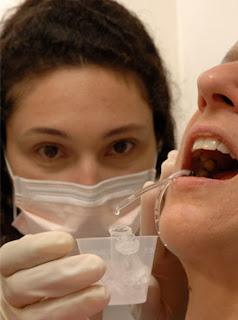About Water Content Of Saliva And Saliva
Womb
In animals, saliva is produced and secreted from the salivary glands. As for abortion are:
* Electrolytes: (2-21 mmol / L sodium, 10-36 mmol / L potassium, 1.2 to 2.8 mmol / L calcium, 0.08 to 0.5 mmol / L magnesium, 5-40 mmol / L chloride, 2-13 mmol / L bicarbonate, 1.4 to 39 mmol / L phosphate)
* The mucosa, which mainly contain mucopolysaccharide and glycoprotein
* Antibacterial compounds (thiocyanate, hydrogen peroxide, and immunoglobulin A)
* Some kinds of enzymes, including alpha-amylase (EC3.2.1.1), lysozyme (EC3.2.1.17), and lingual lipase (EC3.1.1.3).
Amylase and lipase in a row to start digestion of starch and fat before the food is swallowed. These enzymes work optimally at pH 7.4. Lingual lipase has a pH optimum ~ 4.0, so it will not be active if it has not entered an acidic environment. Lysozyme plays a role in bacterial lysis. Saliva also contains human saliva acid phosphatase A + B (EC3.1.3.2), N-asetilmuramil-L-alanine amidase (EC3.5.1.28), NAD (P) H dehydrogenase-quinone (EC1.6.99.2) , laktoperoksidase saliva (EC1.11.1.7), superoxide dismutase (EC1.15.1.1), glutathione transferase (EC2.5.1.18), class 3 aldehyde dehydrogenase (EC1.2.1.3), glucose-6-phosphate isomerase ( EC5.3.1.9), and tissue kallikrein (EC3.4.21.35). The existence of these products sometimes result in saliva smells.
Humans spend approximately 700 ml of saliva per day.
Some people might find sterile saliva or disinfectant, so believe that saliva will more quickly heal wounds. In fact, the mouth is a hotbed of germs and bacteria. There are over 600 types of bacteria in the mouth and saliva that can cause infection. As quoted from the following MSN secret behind saliva:
What is in saliva
Most of saliva is water, but also contains electrolytes, bacteria, viruses, fungi, secretions from the nose and lungs, cells from the lining of the mouth and about 500 proteins. Of course, the contents of saliva also depends on what you put into the mouth, such as food debris. Components toothpaste also commonly found in saliva. The content of saliva every person is different.
What can be known from saliva?
Of saliva, can be obtained from DNA samples. In fact, although saliva does not contain the DNA of cells, but cells from the lining of the mouth can be found in saliva samples. Saliva is also another clue to the identity of a person's menungkapkan. Saliva may reveal what has been eaten and drugs that may be consumed, such as cocaine, marijuana and barbiturates. Scientists can also use saliva samples to show how much of certain drugs in the body.
The scientists also want to be able to use saliva as a tool to detect the disease, because it is much easier, and in many cases more secure. HIV testing is one of the saliva test which is used as
sample, although the blood test is still the standard way to test for HIV.
What are the functions of saliva
Some people do not realize how important functions of saliva, namely:
- . Break down food in the mouth, so it can be perceived by the tongue and is more easily digested by the stomach.
- . Clean food and dead cells from the lining of the mouth
- . Binds food into a ball so that it can be swallowed
- . Clean food and bacteria from the teeth
- . Prevent dry mouth lining
- . Destroying or preventing the growth of certain fungi
- . Neutralize acids from foods and beverages
- . Help regenerate the damaged tooth enamel, due to calcium and phosphorus levels
How much amount of saliva?
Goodson
estimate the average person produces about half
liters of saliva a day. But of course this number is also
influenced by several factors, among others:
- . Genes
- . Time (saliva production slows down drastically at night)
- . Much water you drink
- . Was chewing gum or sucking hard candy (both increase the production of saliva)
- . Smelling something interesting (also increase saliva production, which is why there is the term 'delicious')
- . More than 400 medications cause a decrease in saliva production
- . Age production (saliva decreases with age)
- . conditions or diseases that affect the production of saliva,
- .such as Sjogren's syndrome, or are undergoing radiation therapy.

















